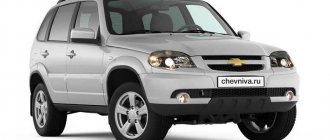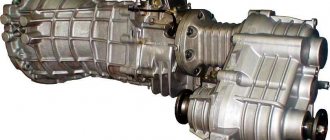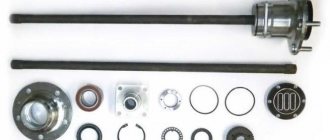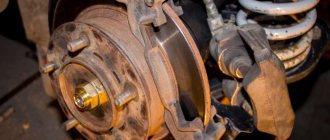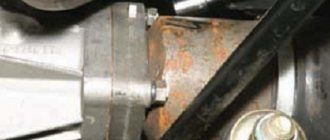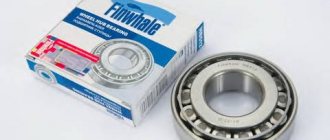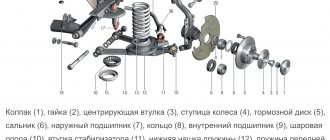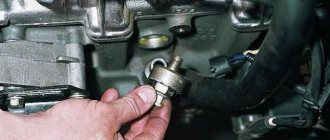Content
- "Chevrolet Niva" and "Lada Niva": comparison of differences
- Safety and comfort "Niv"
- LADA 4×4 and Chevrolet Niva off-road
- What is more difficult and more expensive to maintain: Chevrolet Niva or Lada 4x4
- Resale choice: what sellers offer
- Problems of old people in the secondary market
- What to buy: Niva or Chevrolet Niva
Standard comparisons of “father and son” or “grandfather and grandson” will not apply to these cars: there is not such a large time gap between Tolyatti SUVs. They are more like brothers. The traditional lack of development budgets for the late nineties led to the fact that instead of a full-fledged second generation of the Niva, we received a heavily modernized first one, albeit with a different nameplate on the hood. However, there will still be quite a lot of differences. Let's talk about them.
Niva Chevrolet
This model has an updated and modern design, and the ride on it is much more comfortable compared to the regular model.
Its main advantages are as follows:
- Successful and modern design;
- Better passive safety;
- More comfort while driving. The driver's position is quite comfortable, there is less vibration and extraneous noise;
- The power unit is installed from Niva and slightly modified, with a volume of 1.7 liters and 80 horsepower;
- Rigid body, and thicker side members than a regular Niva;
- Excellent aerodynamics and spacious interior;
- The suspension is spring type, the rear part has a dependent variation, and the front part has an independent one;
- Feels great off-road.
This car is suitable for long-distance driving and performs well on harsh off-road conditions. Shevik combines two important qualities: high functionality and good comfort. The disadvantages include a weak engine and high fuel consumption, which is about 14 liters per hundred. Many are also concerned about the type of drive on the Chevrolet Niva, the answer is very simple, it is equipped with permanent all-wheel drive, a transfer case that has several functions, and also has a locking differential between the wheels.
To summarize, we can conclude that if you need a car for driving mainly off-road, comfort is not very important, and appearance then you should choose a regular Niva 4X4. If, on the contrary, you are going to drive more often on asphalt roads, then it is better to opt for the Niva Chevrolet.
"Chevrolet Niva" and "Lada Niva": comparison of differences
Officially, since 2004, it, of course, was and is called LADA 4x4, but it still continues to be called simply “Niva” from old memory. Because legal subtleties and copyrights are far from the common man.
And this is fair, because both Nivas have a related chassis, a related transmission and a confusingly similar 1.7 liter engine. They were even modernized, plus or minus together or one after another: the rear suspension mounting points were changed, the cardan shafts were equipped with CV joints, and noise and vibration insulation was improved.
But, despite the commonality of the initial base and modifications, there are many differences. So, the Chevrolet Niva has a different engine mount, a different oil pan, and an original intake tract. The transmission control is different: the LADA 4×4 has three transfer case levers in the cabin, while the Shniva has two. It’s just that in the original, the activation of the lowering and the locking of the center diff are assigned to different levers, while in the later successor they are hung on one.
Also read: Test drive Lada 4×4: Urban does not mean urban
Regular 4X4
Despite the fact that the design of the regular two-door Niva is outdated, and it is often criticized for its clumsy appearance, it continues to be in great demand.
The developers made attempts to release a new version of the SUV, as a result of which the Lada 4X4 Urban was released for sale. But there were no fundamental changes in the design, so there was little demand for it.
The main advantages of the regular Niva compared to the Chevrolet Niva are as follows:
- Thanks to its short wheelbase, the model has better cross-country ability;
- Lower Price;
- Time-tested, unpretentious engine with a volume of 1.7 liters and 83 horsepower, with excellent torque;
- The price of spare parts is cheaper;
- A time-tested gearbox that works perfectly and does not fail in any extreme conditions;
- Has a great predisposition to tuning;
- Reliable suspension on levers.
Despite all the positive aspects, this car also has its drawbacks. It is very difficult to move along the highway, as you need to hold the steering wheel tightly to prevent unauthorized maneuvers. Of course, the short wheelbase feels great in rough off-road conditions, but on a normal road at high speeds it has poor handling. As for comfort, it is also at a low level, this is due to constant vibrations and extraneous noise.
Despite all the shortcomings, the Regular Niva looks good; its main advantages for the buyer are simplicity of design, ease of maintenance, and price.
Safety and comfort "Niv"
The main differences between the two “grandfathers” lie not so much in technology, but in comfort and safety options. For example, LADA 4×4 still does not have seat belt pretensioners, and air conditioning appeared in the list of options only after 2014 with the release of the Urban version.
The 4x4 interior is dramatically inferior to the Niva in terms of visuals and comfort. Firstly, even after all the upgrades, it looks like 1977. Secondly, it’s cramped, narrow, and noisy. The Shniva is also not exactly a Mercedes, but the 2009 restyling from the Bertone studio at least brought its interior closer to the standards accepted in low-cost cars: a three-spoke steering wheel, cup holders, more or less ergonomic chairs, and more recently and the media system with navigation is still ultra-budget and Togliatti, but it no longer looks shameful.
The two brothers are greatly distinguished by the number of modifications - both factory and not so. Chevrolet Niva is a non-alternative five-door body; 4×4 already comes in three- and five-door versions from the factory. And also - a pickup truck, a van, an all-terrain vehicle. And this is not counting semi-amateur crafts like mobile homes.
The Chevrolet Niva can only boast of factory tuning like the Winter Edition and SE trim levels, which comes down mainly to different bumpers, special paint, wheels and a standard snorkel.
Also read: Chevrolet Niva - from dirt to city. One owner experience
VAZ 2131 “crocodile” vs Chevrolet Niva: from each according to needs
Agree, it’s nice when others guess your desires. For example, someone will think that you dream of a foreign class C car at a reasonable price - and here it is, an assembly plant in Vsevolozhsk. Or he will think that you really want something expensive, but domestic - he will be lucky to bring BMW components to Kaliningrad.
Also interesting: 5 cheapest tracked all-terrain vehicles -
The most enterprising ones decided to play on eternal values - the need of the broad Russian soul to communicate with their native nature. So, the product of joint creativity of Russian designers and American investors - the Chevrolet Niva - stood on a par with the Niva.
More precisely, he didn’t even get up, but climbed up and started pushing with his elbows. It’s not painful, but it’s assertive. To see who will push whom, we took a brand new, brand new, extended Niva VAZ 2131 with a carburetor engine ($7,700) and a Chevrolet Niva in the “Norma” configuration ($9,900).
What other options are there? “Thirty-one” can be chosen with an injection engine ($7900). And the Chevrolet Niva comes in a “luxury” configuration ($11,100) with cast wheels, tinted windows, heated front seats, and a velor interior.
LADA 4×4 and Chevrolet Niva off-road
If you compare the differences between the two old men off-road, you need to approach this issue from two sides:
- if we compare production models;
- when comparing modified models.
The serial ones are identical in cross-country ability, plus or minus, with the difference that the short-wheelbase (2.2 m) three-door is more mobile and flexible off-road than the Niva with its 2.47 meters between the axles. But their transmission and engine limits are close.
But as for the modified versions, there is an endless field of experiments: a Niva on “toothy” wheels will go much further than a 4x4 on standard road wheels. A LADA 4×4 with a snorkel will sail where the factory Niva will stand. And, on the contrary: a Niva with a winch will crawl out of places where an unfinished 4x4 won’t even approach.
In the case of non-factory options, off-road tuning elements begin to play a key role, and the list of differences tends to infinity.
Also read: The Germans about the Lada 4X4: “The car has one name…”
What is more difficult and more expensive to maintain: Chevrolet Niva or Lada 4x4
Same. With a plus or minus note. The market price for the front bumper of the 4x4 Urban is 6,990 rubles, for the Shniva - 6,990 rubles. A windshield for a 4x4 costs around 2,450 rubles, for a Niva – 2,100-2,700 rubles. Bosch oil filter - 318 rubles for 4x4 and 426 rubles for Niva. Complete engine - 66-93 thousand rubles for both.
In general, owning them in everyday life costs about the same amount of money. If you exploit it to the fullest - in the taiga - then there are possible options that are impossible to calculate: everything is too individual.
Servicing a LADA 4×4 will be insignificant, but more expensive if we are dealing with a new or just a warranty car: its maintenance regulations require more frequent visits to the dealer - once every 10 thousand km, versus 15 thousand km for the Niva. As a result, over three years of ownership (or 30 thousand kilometers), LADA 4x4 will require four service visits and maintenance for 28,600 rubles, Niva - three visits and 22,100 rubles (manufacturer prices for September 2020).
Also read: UAZ Hunter was tested in Japan: what impressions did the Russian SUV leave?
Technical characteristics of Niva 2121, Niva 2131 and Niva Chevrolet
At this point, we collected all the remaining indicators, since a number of parameters were left unattended. Let's list at least the priority ones.
- Smooth ride.
- Comfort level.
- Dynamics.
- Controllability.
- Safety.
But for a review article, the specified parameters will be sufficient. These are fundamental indicators for a possible owner or typical stakeholder.
In terms of smoothness, the leader is the extended version of the SUV, since its weight significantly exceeds the weight of the Chevy and the classic Niva. However, if we remember such a concept as operating comfort, then leadership will go to the Chevrolet Niva. The reason for this is power steering (although modern versions of the classic VAZ 2121 have power steering and air conditioning), a more comfortable driving position, improved sound insulation, and ergonomics.
VAZ designers managed to change some of the kinetic qualities of the Chevrolet Niva without technical changes. For example, redistribution of the center of mass has led to increased stability on the road, which directly affects the smoothness of the ride. Reduced vibration can also be considered a secondary factor.
Also interesting: Military UAZ 469 - Military axles, self-block, disc brakes
To compare dynamics, you cannot only rely on engine power. There are many examples in which cars with less power have high speed qualities. Thanks to improved aerodynamics and streamlining, the Chevrolet Niva has become more controllable, predictable and dynamic.
In terms of safety, all Niva car models lag significantly behind existing competitors by modern standards, but even if we compare the Niva 2121, Niva 2131 and Chevrolet Niva, then in this regard the Chevrolet Niva looks more profitable. This benefit is evident even in terms of passive safety.
Resale choice: what sellers offer
The choice of aftermarket cars is rich: 4,000 Chevrolets and 7,500 4x4s. After all, the original Niva has been on the assembly line for more than 40 years, Niva for almost twenty. With an eye on trouble-free driving every day, of course, you need to look at the latest options. All the factory modifications are screwed in there, of which there are quite a few. There is minimal mileage and the most advanced equipment. In the case of LADA 4×4, let me remind you, this is an air conditioner, in the case of Niva it is a media system.
If you dig around and look for exotics, you can find pre-restyling Chevrolet Niva with an experimental 1.8 liter, 122 hp engine. With. from Opel. Now it’s almost a museum rarity, the number of offers on the market barely exceeds a dozen, but it’s worth it: it has a much better interior (with seats made by the same Opel) and a Japanese Aisin transmission. And it’s inexpensive: the rare Niva Fam1 can be found ranging from 260 to 500 thousand rubles. True, the mileage is corresponding: 200-300 thousand km each.
But mostly, of course, there will be simpler cars - with the native Tolyatti 1.7 liter. And you have to choose meticulously: there are no two identical copies (just as there were none even when they came off the assembly line).
Also read: Chinese “SUV” at the price of “Niva”: review of Lifan X60 I (before restyling)
Problems of old people in the secondary market
Most problems at the start can be identified by checking the operating history. Here, for example, is a nice option: not the most record-breaking mileage, bargaining is announced at the hood.
And there will be plenty of reasons to bargain. At a minimum, because the car is broken.
And it was seriously beaten - from the front and from the side.
In general, let’s move on right away and see what the owners of Shnivy offer.
And again the report from avtocod.ru tells us not to waste time and move on immediately.
Firstly, the car has a lot of owners and a duplicate title - it is very worn. Secondly, the mileage is covered. Thirdly, there is a ban on registration actions on the car. We don’t even waste time on inspection and look further.
Also read: Lada Xray: the whole truth from the owner’s lips
Test results
Expert assessments were given based on a number of criteria.
Ergonomics. Vesta provides good planting geometry. XRAY is worse, despite adjusting the steering wheel for reach and a new seat. Niva is about the same level, but unless you are above average height (the range of seat adjustments is limited). But visibility is better (huge mirrors, powerful headlights). Vesta is let down by wide pillars, and XRAY is let down by small mirrors.
Dynamics. Vesta accelerates and turns more pleasantly than anyone else. The Niva is slow, but its connection to the gas pedal is much clearer than that of the more dynamic XRAY, which is uncomfortable to drive. Equal scores with the Niva for handling are associated only with the lack of a stabilization system on the Niva - the chassis itself is better tuned.
Ride comfort. Despite the additional sound insulation of the Cross version, XRAY turned out to be noisier than Vesta due to the disgusting sound of the engine. Niva in the “civilian” version without a snorkel does not frighten with unnecessary noise at all permitted speeds and is noticeably superior to Crosses in terms of smoothness.
Comfort in the cabin. Vesta is longer than the others and, as expected, wins over everyone in terms of rear space and trunk volume. And the compartment is well thought out. The Xray and Niva are all more modest, and the Chevrolet transformation is from the last century: to recline the backs of the rear seats, you first need to raise the pillows.
Do you agree with these assessments?
Also interesting: Tire size for a field, all-season tires for a 4×4 field, mud tires, the best winter tires for r16 wheels
Let us remind you that we previously talked about how the Lada Vesta Cross and Lada XRAY Cross withstood the Karakum route (9000 km).
